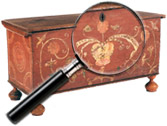|
|
Chocolate Pots
Chocolate was first imported into Europe by the Spanish in the early sixteenth century from their possessions in central and south America. The Spaniards were able to keep the beverage a monopoly inside their empire for nearly a century, but by the mid-seventeenth century “Chocolate Houses” were opening in London. Chocolate pots appeared within a few decades as vessels expressly designed to serve the increasingly fashionable hot chocolate beverage. As a luxury [...] Click here to continue reading.
A Chapter in the Mallard Legend: The Family Offers His Personal Possessions at Auction
Families that inherit historical artifacts related to their famous or infamous ancestors often possess both a blessing and a burden. So it was for the descendants of Prudent Mallard (1809 to 1879), the renowned New Orleans 19th century merchant and probable cabinetmaker.
When Mallard’s widow, Augustine, died in 1889 (ten years after Prudent) her will contained instructions for the division [...] Click here to continue reading.
The Prudent Mallard Legend
Prudent Mallard (1809 to 1879) was a renowned New Orleans nineteenth century merchant and probable cabinetmaker. Many collectors and experts consider Mallard to be the leading, even iconic, figure in nineteenth century furniture in the lower South. Tom Halverson, Director of American Furniture and Decorative Arts for the New Orleans Auction Galleries believes that Mallard’s fame was well deserved. “I believe that by the middle of the nineteenth century the [...] Click here to continue reading.
Tongzhi
The term Tongzhi refers the reigning era name for the 10th Qing Emperor, Aixin-Jueluo Zaichun (1856 to 1875), who reigned from 1861 to 1875. The Tongzhi emperor was the third to last emperor to reign over all of China before 2,000 years of imperial dynastic history came to an end in 1911.
Augustus B. Koopman (American, 1869 to 1914)
Born in Charlotte, North Carolina, Koopman was one of an elite group of American art students admitted to the Ecole des Beaux-Arts in Paris. After his course of study, he remained in Europe, winning medals and honors on both sides of the Atlantic, including the major international expositions at Paris (1900), Buffalo (1901), and St. Louis (1904). The artist spent his winters in Paris, traveling during the [...] Click here to continue reading.
Sgian Dubh
The Sgian Dubh is the traditional Scottish dirk used for centuries as a weapon and known to non-Scots as the dirk worn with highland dress. It is pronounced (Skeen’ Doo) which is the source of an occasionally seen spelling variant, skean-dhu.
The Sgian Dubh began life as a short utility knife but gained cultural importance when the English proscribed Scots from carrying weapons and wearing the kilt. Sgian is the Gaelic word [...] Click here to continue reading.
Staffordshire Pottery Figures
Overview
In the late 18th and early 19th centuries, British nobility and the well-to-do merchant class indulged their passion for ceramics by purchasing the expensive and refined porcelain made by the German Meissen factory and the English Chelsea, Bow, Wedgwood and Worcester works. Meanwhile, the ceramics workers in Staffordshire offered more humble and naive pottery figures at modest prices to decorate the cottages of the folk on the lower rungs of [...] Click here to continue reading.
Derby & Bradley
Derby, Bradley & Co. was established in 1844 as wholesale and retail dealers in books on a wide variety of subjects, including law, medical, historical and theological topics. In addition their list included many school books. The firm has the reputation of having operated the largest and most elaborate bookstore in the West.
The firm’s founding partner was Henry Derby, who moved to Cincinnati in 1840 from Columbus where he [...] Click here to continue reading.
Thangka
A Thangka is a silk painting with embroidery, usually Tibetan. They were usually religious in nature and the subject matter would be a Buddhist Deity, a mandala, the Wheel of Life, events involving Lamas, or historical events. The Thangka was used as a teaching tool by traveling monks as they were light in weight, and easy to roll and carry.
Reference note by p4A editorial staff, August, 2011.
Fire-King
Known for practical and affordable glassware, Fire-King produced a wide range of products in the 1940′s that collectors love-and still use.
Inexpensive & Attractive Designed to be inexpensive and attractive, Fire-King glassware was the result of a merger of the Anchor Cap and Closure Corporation and the Hocking Glass Company. Formed in 1937, Anchor Hocking introduced its popular line of Fire-King glassware in the early 1940′s. Fire-King products were designed to be [...] Click here to continue reading.
|
Recent Articles
- Charles Alfred Meurer – American Artist & Tromp L’Oeil Artist
- Sendak, Maurice – American Artist & Writer
- Godie, Lee – American Artist
- Davis, Vestie – American Artist
- Bartlett, Morton – American Artist
- Mackintosh, Dwight – American Artist
- Evans, Minnie Jones – African-American Artist
- Mumma, Ed (Mr. Eddy) – American Artist
- Nice, Don – American Artist
- Savitsky, John (Jack) – American Artist
- Gordon, Harold Theodore (Ted) – American Artist
- Dial, Thornton – African-American Artist
- Doyle Sam – American Artist
- Johnson, Lester Frederick – American Artist
- Finster, Howard – American Artist
|
|
